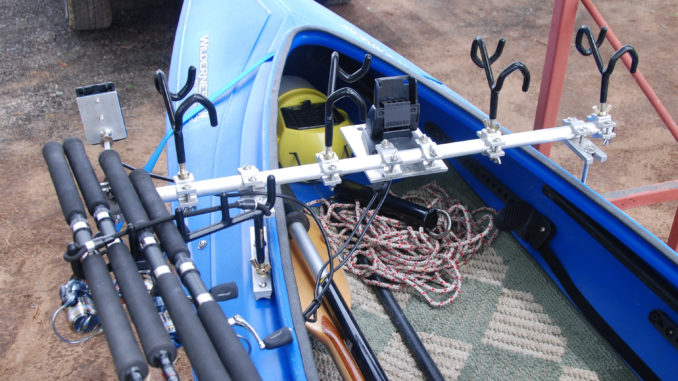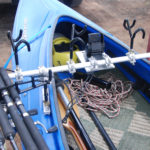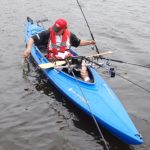
Rod-holder maker solves plastic-metal problems
Take a guy with an engineering background who has designed metal rod holders his whole life, put him in a plastic boat, and you can see the wheels begin to turn. That was David Baynard of Driftmaster Rod Holders about three years ago. Fortunately, no one ever told Baynard the rule of kayaking — that metal and plastic don’t play well together.
“I’ve always been a fan of small-boat fishing from when I was a kid,” said Baynard, whose company is based in Manning, S.C. “But our market with Driftmaster has traditionally been big boats like pontoons and center consoles, for people who catch catfish, crappie and stripers using a bunch of rods. When I got my first kayak, I took it as a challenge to turn this little plastic paddle boat into a fishing machine.”
As Baynard saw the situation, before he could add the tools he needed for fishing, he needed to establish a base to mount equipment that was within easy reach of his seat in the kayak. He also realized that due to space restraints, he needed to design a method for the base to rotate out of the way when he entered and left the craft.
“I already had a product, the T-1000 trolling bar, that was designed for small boats,” he said. “It’s a rod-holder bar that goes across the boat just forward of the seat. It can hold four rod holders and still has room on each end to attach other accessories.”
Tackling the job of combining metal and plastic boils down to connection points. Having touted the benefits of metal rod holders over plastic ones for years, Baynard wasn’t about to relent. As he sees the situation, it’s not as big a deal as most end-users make it out to be.
“Whether you use metal or plastic, you still need a large footprint that will spread the stress out over a larger area,” he said. “That way you don’t end up breaking through the plastic.”
Using extruded aluminum bases several inches larger than required when attaching to metal or fiberglass, it was simple enough to expand the footprint. The problem was how to connect the bases.
“The suggestions from the kayaking folks I talked to was to bolt the bases on with supports placed on the inside,” he said. “But you can’t always reach the insides of some of the sit-on-top models, so I intentionally used only screws to attach the bases. I figured, worse case, I’d damage my own boat, but better mine than somebody else’s.”
Despite an elaborate base-and-bar system, even one where one end of the bar disconnects and swings away to allow the paddler to get in and out of the boat, Baynard said he’s had no problems with the screws either failing to perform or damaging the material beneath the base.
With steps one and two down, it was on to designing a way to mount a depth-finder transducer and some way to anchor the boat.
“In my experience, the hardest transducer to mount on any boat is one of the side-imaging models, because it has to extend down in the water below the lowest point so it will work correctly,” he said. “My kayak has a rudder system, and a phone call to the depth-finder manufacturer suggested that I mount the transducer to the rudder. I didn’t care for that suggestion because one, it really inhibited the steering control of the kayak and two, I wanted to read from the front of the boat, not the back,” he said.
Baynard designed a transducer-mounting arm that would attach to the end of the trolling bar. Though not officially on his product list yet, the arm rotates to allow the head of the transducer to extend well below the boat to get proper readings underwater and rotate back up when the boat is in shallow water or beaching.
The last challenge for Baynard’s quest to fully rig his plastic boat was a way to solidly anchor the kayak in shallow water and control drift for trolling in the wind or current. He said he’s had moderate success with one and good success with the other.
Since the Power Pole made it’s mark on the fishing world several years ago, many anglers and manufacturers have rushed to add a vertical anchor system to their arsenal. Kayakers have used stake-out poles for years, more out of necessity than fashion. Baynard modified his Pole Anchor system to fit and has had some moderate success.
“The metal pole is 12 feet long, and to me can be cumbersome to handle in a kayak, especially when you have to paddle into position to put the pole out,” he said. “Fortunately, the pole is sectional, so I just removed one section and found the 8-foot pole to be much easier to handle. In fact, it gave me the idea to design just a section of metal rod that I could attach to the kayak with a rope for a controlled drift,” he said. “It’s not a finished product yet, but the concept is promising.”
For more information on Driftmaster’s paddling-based products, visit www.driftmaster.com.






Be the first to comment